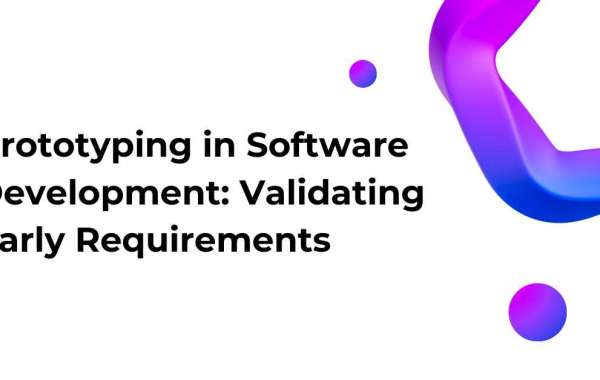Introduction
In the fast-paced world of software development, ensuring that a project's requirements align with the client's vision is essential for success. Prototyping is a powerful technique used to validate these requirements early in the software development process. In this blog, we will explore the concept of prototyping, its role in software engineering, and how it can save time and resources by ensuring a clear and accurate understanding of client needs.
Prototype Model in Software Engineering: Understanding the Basics
The Prototype Model is a popular approach in software engineering that focuses on building a functional, early version of the software system. This prototype acts as a tangible representation of the system, allowing stakeholders to interact with it, provide feedback, and validate requirements. Let's delve deeper into the prototype model and how it fits into the software development process.
Prototype Model in Software Engineering: Characteristics
- Early Demonstration: The prototype model emphasizes creating a partial or complete working system early in the development cycle. This allows stakeholders to see and experience the system's functionality.
- Iterative Process: It is an iterative approach, with the initial prototype serving as a foundation for successive versions. Feedback from each iteration guides the development of subsequent prototypes.
- Client Involvement: The client or end-users play a pivotal role in the development process. Their active participation in reviewing and testing the prototype ensures that the final product meets their expectations.
- Adjustable Requirements: Prototyping accommodates changing requirements. As clients gain a better understanding of the system through the prototype, they can refine and adjust their requirements.
Prototype Model in Software Engineering: Advantages
- Clear Requirements: Prototypes provide a tangible representation of the software, making it easier for clients and stakeholders to understand and clarify their requirements.
- Early Feedback: The iterative nature of prototyping encourages early feedback. This helps in identifying and addressing issues or mismatches between client expectations and the software's capabilities.
- Reduced Risk: By addressing concerns and making adjustments early in the process, the prototype model reduces the risk of costly errors or misunderstandings in the later stages of development.
- Client Satisfaction: The high level of client involvement and the ability to adjust requirements as needed contribute to improved client satisfaction and a higher likelihood of delivering a system that aligns with their vision.
Prototype Model in Software Engineering: Disadvantages
- Time-Consuming: Developing prototypes and iterating through them can be time-consuming. This may not be suitable for projects with strict time constraints.
- Scope Creep: Frequent changes to requirements can lead to scope creep if not managed effectively, potentially affecting the project's timeline and budget.
Prototyping in Software Development: How It Works
Now, let's explore how prototyping fits into the software development process and the steps involved:
- Understanding Requirements: The first step in prototyping is to gather and understand the initial requirements. These may be incomplete or vague, making it crucial to involve stakeholders in defining and clarifying their needs.
- Prototyping: Based on the requirements, a prototype is developed. This can be a throwaway or evolutionary prototype, depending on the project's needs. The goal is to create a working model that demonstrates key functionalities.
Scheduling Algorithms in Operating System: A Comparison
To understand the benefits of prototyping, let's draw a parallel to the world of operating systems, where scheduling algorithms play a crucial role. Scheduling algorithms are responsible for determining the order in which processes are executed by the CPU. There are several scheduling algorithms in an operating system, each with its own set of advantages and disadvantages.
Scheduling Algorithms in Operating System: Characteristics
- Round Robin: Round Robin is a simple scheduling algorithm that allocates a fixed time quantum to each process in a circular order. It ensures fairness and prevents a single process from monopolizing the CPU.
- Shortest Job Next (SJN): SJN, also known as Shortest Job First (SJF), selects the process with the shortest burst time to execute next. This minimizes waiting times and enhances overall system efficiency.
- Priority Scheduling: Priority scheduling assigns a priority level to each process. The CPU executes the highest-priority process first. This algorithm allows for the execution of critical tasks promptly.
- First-Come, First-Served (FCFS): FCFS is a non-preemptive scheduling algorithm that executes processes in the order they arrive in the ready queue. It is simple but can lead to long waiting times for high-burst-time processes.
Scheduling Algorithms in Operating System: Advantages
- Fairness: Round Robin scheduling ensures that all processes get a fair share of CPU time, preventing any one process from starving.
- Efficiency: SJN optimizes system efficiency by minimizing waiting times and maximizing CPU utilization.
- Priority Handling: Priority scheduling is valuable for handling critical tasks with a high-priority level, ensuring they receive immediate attention.
- Simplicity: FCFS is a straightforward scheduling algorithm that is easy to implement and understand.
Scheduling Algorithms in Operating System: Disadvantages
- Context Switching Overhead: Round Robin introduces context switching overhead, as processes are switched frequently, which can impact performance.
- Predictability: SJN relies on having accurate burst time information, which may not always be available in real-world scenarios.
- Starvation: Priority scheduling can lead to starvation, where low-priority processes are delayed indefinitely if higher-priority processes are constantly arriving.
- Convoy Effect: FCFS can suffer from the convoy effect, where small processes are delayed behind a large, long-burst-time process.
Prototyping vs. Scheduling Algorithms: A Comparative Analysis
Prototyping in software development and scheduling algorithms in operating systems share some interesting similarities:
- Iterative Nature: Both prototyping and scheduling algorithms involve an iterative approach. Prototyping uses multiple iterations to refine the software, while scheduling algorithms continually choose the next process to execute.
- Client/User Involvement: In both cases, client or user involvement is essential. In prototyping, clients and stakeholders provide feedback, while in scheduling algorithms, the execution order is influenced by the priority and arrival time of processes.
Conclusion
Prototyping is a valuable technique in software development that serves as a bridge between the client's vision and the final product. It allows for early validation of requirements, reduces the risk of misunderstandings, and fosters client satisfaction. The prototype model in software engineering, with its iterative nature and focus on client involvement, aligns well with the principles of the SOLID approach.
Drawing parallels to the world of scheduling algorithms in operating systems, we see the importance of early decision-making and efficient processes. Just as scheduling algorithms aim to optimize CPU utilization, prototyping aims to optimize the development process by ensuring that requirements are clear, well-understood, and effectively translated into a working software system.
In the ever-evolving landscape of software development, prototyping remains a key practice for building successful software that meets client needs and aligns with project objectives. It serves as a powerful tool for early validation and ensures that software projects are on the right track from the very beginning.










